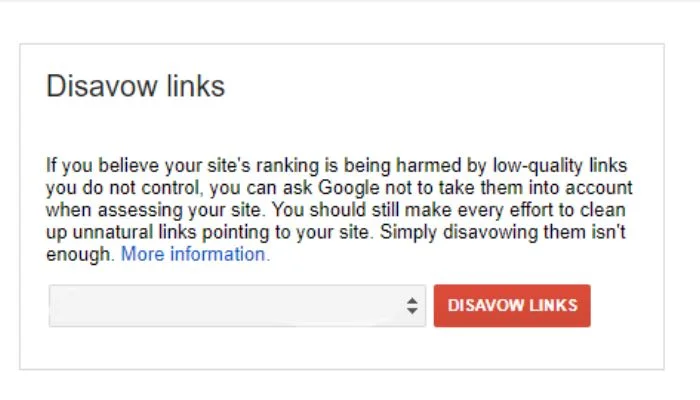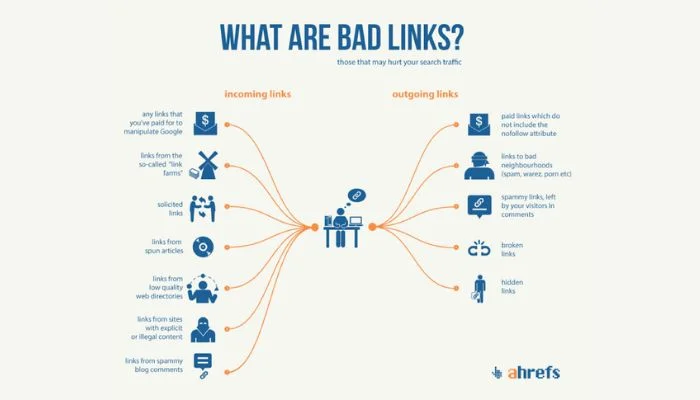How to Safely Disavow Backlinks

Search engine optimization (SEO) is an essential element of promotional strategies for businesses. In fact, Quality backlinks are a key factor in gaining a higher search engine ranking, growing organic website traffic, and ultimate success for the company.
The issue arises when low-quality or spammy backlinks start to negatively affect performance due to content marketing attacks or manipulative techniques.
But don't worry, we got you! Protecting your website requires identification and responsible disavowing of these harmful links, which is what this guide is made for. Let's discover the importance of acknowledging this threat, identifying and evaluating spammers, and implementing safe disavowal techniques for total website protection.
Understanding Backlink Disavow

Backlink disavow is a tool used by website owners to submit the details of unsafe or spammy backlinks on their sites to search engines, such as Google, using the Google Disavow links tool. These malicious backlinks may be negatively influencing one's SEO performance and should be disavowed in order to protect their organic search rankings and reputation.
By disavowing links from shady SEO sites through the Google Disavow tool, webmasters are also helping web syntax indexing bots understand not to put any weight into those links when crawling the websites. This process provides an appropriate signal to search engines that all the backlinks from these sources should not count when calculating website value, thereby maintaining a clean and credible link profile.
Differentiating disavowing and removing backlinks
Disavowing and removing backlinks are separate processes that have different levels of effectiveness for websites. Disavowing is a process through which webmasters tell search engines not to "count" particular bad links while they remain in directories or other external websites.
On the other hand, link removal is a more intensive labor requiring request letters sent directly to each known webmaster and when allowed, outright removal by the same user/owners with permission from outside sources like renter hosting services.
Maintaining a disavow list in tools like Google Analytics is essential for tracking and managing bad backlinks that can negatively impact search results. By disavowing bad backlinks pointing to your site, you can prevent them from affecting your website's SEO performance and overall ranking on search engine results pages (SERPs).
Consequences of negative SEO attacks and spammy backlinks
The consequences of having negative SEO attacks and spammy backlinks targeting your website can be devastating. These types of external links, if left unchecked, can affect the organic search engine rankings and traffic to a website as well as invite manual penalties which require professional intervention.
Negative SEO involves intense saturation on malicious tactics such as link farms or hit-and-runs that favor sustainability over quality standards set by search engines. Through continued strategic optimization over time, the goal is to further damage a competitor’s website or steal their market share.
Identifying Spammy Links

1. Analyzing link quality indicators
Sudden influx of low-quality backlinks
Analyzing sudden influx of or a surge in low-quality backlinks is an important link quality indicator during disavowal.
This involves looking out for instantaneous increases of identical/spammy anchor text dominating the website's backlink profile as well as analysis around rankings indicators, freshness count, referral traffic et cetera - it could be considered an affair that compromises long-term positive outcomes for search visibility if disregarded and left unaddressed.
Agencies must ensure mechanisms in place for pushing those spammy values below average uptime of query return rate for a project's benefit in the SEO agency lexicon.
Irrelevant anchor text or content
Analyzing link quality indicators concerning irrelevant anchor text or content (and Google itself) is a good way to identify spammy backlinks. Typically, qualitative links, or those that directly correlate to the type of product and service advertised on a website, are signs pointing towards benign activity while foreboding metrics include trivial non-relevant words not related in any content or otherwise visible connection. Because suspicious websites often resort to link redirect scripts, sometimes they end up using incorrect titles or deceptive labels leading from one page to another.
Maintaining a text file with all the bad links to your site can help in monitoring and managing your link profile effectively. By regularly analyzing your link profile for any suspicious or low-quality backlinks, you can take proactive measures to protect your website's Google rankings and overall SEO performance.
Links from suspicious or penalized websites
Understanding link quality is critical when evaluating a website’s backlink profile. Among the indicators to consider, are links located on compromised websites or sites with heavy penalties are high red flags of risk for your site.
These connections form weak points and often invite future removal by search engines. Thus, researching proper SEO etiquette as well as scanning networks for potentially malicious actors via manual or automated checks can help ensure website safety and appropriate impact among target SEO demographics.
2. Utilizing Google Search Console

Accessing the Links report
Google Search Console provides invaluable insight into evaluating the quality of backlinks and webpages associated with a website. The “Links” report found herein is especially helpful when preparing to create a links disavow file to get rid of any malicious or spam links pointing to a website for safety.
In this report, users can enter their domain name and analyze detailed information about external linking websites as well as other websites using various diagrams that visualize those link sources. Identifying and disavowing Toxic backlinks through this process can lead to a ranking boost and improved SEO performance for the website.
Utilizing other SEO tools for in-depth analysis
Google Search Console is a powerful disavow tool that provides insights for webmasters about their website’s backlink profile. In particular, when it comes to disavowing unwanted backlinks, it can be used to access detailed information regarding who's referring websites link.
Google Search Console enables webmasters to analyze linking domains and anchor text index useful for distinguishing which other establishing quality links from toxic links needs disallowing on assessment only.
Determining When to Disavow Links
1. Evaluating the impact of spammy backlinks
Decline in organic search rankings
Evaluating the impact of spammy backlinks on a website is important to ensure its safety. One indicator of potentially damaging links is the decline in organic search rankings, which results from non-ideal websites sending unwanted and untargeted linkbacks or otherwise manipulating algorithms for improved rankings.
It's also possible attackers use websites sympathetic to a target webmaster or organization to place malicious linking elements that Microsoft and Google review more favorably.
Manual actions or penalties from search engines
Evaluating the impact of spammy backlinks is important, and one good indicator to look for is a penalty issue from preordained manual software bug review findings. Manual spam penalties can be devastating to SEO ranking and have long-term effects if not immediately attended to. Being cited from Google due to suspicious activities dictates that inadequate backlinks investigations resulted.
Unusual search engine algorithm behavior
Evaluating the impact of spammy backlinks can be achieved to assess if actions need to be taken or not. Paying attention to and monitoring search engine algorithms is a foolproof measure to abolish any potential threat.
Unusual algorithmic behavior such as detecting fallen rankings or upticks in new variations indicates certain optimizations need to change when compared against norms used by past performances for that site.
2. Distinguishing between toxic and harmless links
Understanding the context and relevance of the backlinks
In link analysis for website protection, it is essential to distinguish the harmless links from the potentially toxic ones so that you can properly plan when applying a safe and effective disavowal.
Understanding how competitors create their backlink profiles—and their context/relevance —will provide valuable insights in determining whether certain backlinks are legitimate or part of some malicious SEO attack.
Seeking professional SEO consultation if uncertain
Seeking professional SEO consultation is essential when needing to assess whether a backlink is toxic or innocent. However, discerning the difference between the two does require some expertise.
This means more detailed investigation conducted within the context and looking into link profiles of both famous and nonfamous domains -- which requires true experience carrying inner regularities regarding what link metric characteristics search algorithms deem moderate in authority.
V. Disavowing Backlinks Safely

1. Creating a disavow file
Understanding the disavow file format
When attempting to disavow backlinks from a website, it’s important to understand the designed disavow file format.
This type of list allows webmasters to inform search engines about which spam links should not be associated or taken into account when ranking content in organic searches. The tab-delimited textual document is broken up into two distinct columns listing domains as well as separate URLs used in confirmation links.
Collecting the URLs and domains of harmful backlinks
Collecting the URLs and domains of harmful backlinks is an essential part of creating a disavow file. Removing or affirming suspect invitations decided upon during link analysis can be included in the document, as well as their suspected offenses looped back to recent changes impacting digital performance metrics.
2. Uploading the disavow file to Google Search Console
Accessing the Disavow Tool
Uploading the disavow file to Google Search Console can help to protect a website from spammy backlinks, manual action penalties, and negative SEO attacks. In order to upload the disavow file correctly and safely, it is important to access the Disavow Tool through Google Search Console.
Submitting the disavow file for the website
Using the disavow tool in Google Search Console is vital for safe backlink disavowal. A verified profile must be linked with the website before processing further actions. After collectively gathering all URLs and domains which require disavowing into a text document, begin keying in the list one item by one, reading thoroughly each window that opens up until every domain of harmful links is decimated.
3. Monitoring and evaluating the effects
Tracking the disavowed links' removal or devaluation
Keeping track of the removal or devaluation of disavowed links is important to assessing the impact on search engine rankings.
Tracking metrics like organic click-through rates, website ranking positions and referring domains over time will help evaluate if a disavowal had been successful in eliminating low-quality links and increasing the search engine performance of a website. Professional consultation with an expert SEO may prove beneficial when analyzing complex link metrics.
Conclusion
It is essential for website owners to understand and know how to safely and properly disavow backlinks to keep a clean backlink profile.
By recognizing potential dangers in unnatural links and poorly managed backlink profiles, webmasters are better able to protect themselves against toxic backlinks.
investigating observed issues, assessing the need for removal, and proceeding with submitted disavowal can help protect websites from malicious activity threats caused by spammy link accumulation.
Above all else, regular monitoring should occur coupled with always had taken proactive steps ensures website safety expert SEO assistance should be sought where necessary analysis of more complex eventualities arise.
It's ultimately better to have broken links from bad neighborhoods than links for the sake of links.
Interested in our link building services?
Get in touch today!


.svg)

.jpg)
.jpg)
.jpg)